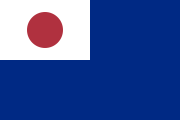This article needs additional citations for verification. (December 2021) |
The Japanese resident-general of Korea (Japanese: 韓国統監, romanized: Kankokutōkan; Korean: 일본의 대 한국통감, romanized: Ilbon-ui dae hangugtong-gam) was the leader of Korea under Japanese rule from 1905 to 1910. This post was highly hated among native Koreans, and international opinion regarded it as nothing more than an imperial sanction to ward off the imperial interests of the western powers.[citation needed]
| Resident-General of Korea | |
|---|---|
| 韓国統監 | |
 Flag of the resident-general | |
| Type | Resident general |
| Status | Abolished |
| Appointer | Emperor of Japan |
| Precursor | Emperor of Korea |
| Formation | 21 December 1905 |
| First holder | Itō Hirobumi |
| Final holder | Terauchi Masatake |
| Abolished | 1 October 1910 |
| Superseded by | Governor-General of Chōsen |
| Deputy | Deputy resident-general |

List of Japanese residents-general
edit| No. | Portrait | Name (birth–death) |
Term of office | Head(s) of state | Ref. | ||
|---|---|---|---|---|---|---|---|
| Took office | Left office | Time in office | |||||
| 1 | Itō Hirobumi (1841–1909) |
21 December 1905 | 14 June 1909 | 3 years, 175 days | Meiji | [1][better source needed] | |
| 2 | Sone Arasuke (1849–1910) |
14 June 1909 | 30 May 1910 | 350 days | [1] | ||
| 3 | Terauchi Masatake (1852–1919) |
30 May 1910 | 1 October 1910 | 124 days | [1] | ||
See also
editReferences
edit- ^ a b c Schemmel, B. (2009). "Countries JK". Retrieved 2009-06-24.
